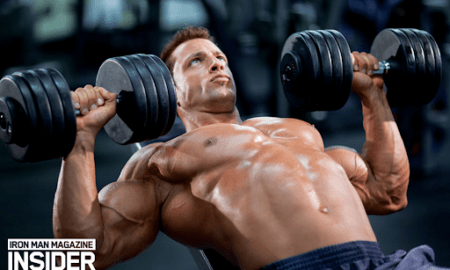
Q: I’ve been training for more than 20 years, and I’ve had trouble with getting my chest to grow. No matter what I do for chest, it lags behind the rest of my body-parts. Do you have any suggestions?
A: Ah, yes, the chest problem. You’ve come to the right place. I’ve had some trouble keeping my own chest development in line with my other bodyparts. It’s usually better to ask a bodybuilder who’s struggled and made gains in a particular area than to ask someone with a genetic advantage in that bodypart. Those who have struggled and made gains have tried every possibility, whereas the guy with the huge chest (or other bodypart) has been gifted in the gene pool and would have great pecs no matter what he did.
I’m going to assume that you have good-to-great triceps. I’m quite sure that if you’ve been training for all those years with your chest not responding, your triceps have been taking the load and have grown. That’s almost always the way it is with the chest and triceps—and it’s a blessing and a curse.
Almost all of the natural bodybuilders I know who have had the chest problem have had great triceps. The two bodyparts are linked in all of the pushing motions. The reasons that you cannot make progress with your chest are many.
If you have long arms and not very wide shoulders, the flat-bench barbell press will be difficult at best and disastrous at worst. Most bodybuilders might be smart enough to suggest using dumbbells instead of the bar; however, that addresses the problem from an old paradigm. Understanding the biomechanics of your arms and your pectorals is essential to finding the correct exercises for each bodypart.
If you do have the long-arm, narrow-shoulder problem, your biomechanical leverage is best on decline dumbbell presses. Your greatest leverage advantage lies with shortening your range of motion. That’s why I suggest that you do four extremely intense sets of decline dumbbell presses, with the most weight that you can manage for 10 reps on the first set (after you’ve done a light set to warm up) and no fewer than six reps on the last set.
Between your sets of decline presses you should be pumping up your biceps. Why biceps? Pumped biceps give you a cushion to press off with when you get the dumbbells to the lowest point of each rep. You don’t want to tax your biceps—just pump them up so that they help you in your pressing motion. That enables you to stay with the same heavy weight on set after set.
Do your first set of decline dumbbell presses after performing a moderately light, high-rep pumping set for biceps. I find that a machine that mimics the preacher curl is best for a quick biceps pump. The idea is to force blood into the biceps and then use that pumped-up feeling for pressing the heaviest dumbbells that you can handle. You’ll find that to be helpful with all pressing motions.
After you’ve done four hard and heavy sets of decline dumbbell presses, move over and do a superset of low-incline flyes (as shown in the illustration) and flyes on a pec-deck machine that has handles (not pads for your elbows) or cable crossovers, keeping your chest up and your elbows pointing back and slightly up toward the ceiling.
Look at the top illustration. Notice how the pectoral muscles are tied into the deltoid and biceps. When doing flyes, always let your elbows move down and back so you get a full stretch. It’s best to do flyes on a slight incline so that the weight is forced to move in the more natural arc that puts stress directly on the pecs.
Be sure to keep your elbows slightly turned up and back on both exercises. Be sure to go from one exercise to the next without stopping. Do no more than two all-out supersets.
The most important idea to keep in mind is this: How do you maximize chest involvement and minimize your already large and powerful triceps? The flye and pec deck motions take the triceps out of the picture altogether while isolating the pecs.
You might also want to consider doing X-reps at the negative end of the flye motion after doing a complete set of 10 to 12 full-range reps. Once you complete your normal set, let the dumbbells bring your arms back as comfortably as possible and move up just a few inches, then back to full stretch. Do those stretch-position partials until your pecs are totally fatigued. As soon as you’re finished, get on the pec deck and do as many full reps as you can; end the set with as many short, contracting X-Rep strokes as possible. That should give you the results that you’re looking for. IM
Editor’s note: You can contact Paul Burke via e-mail at [email protected]. Burke has a master’s degree in integrated studies from Cambridge College in Cambridge, Massachusetts. He’s been a champion bodybuilder and arm wrestler, and he’s considered a leader in the field of over-40 fitness training. You can purchase his book, Burke’s Law—a New Fitness Paradigm for the Mature Male, from Home Gym Warehouse. Call (800) 447-0008, or visit www.Home-Gym.com. His “Burke’s Law” training DVD is also now available, and his second book should be out in early 2008.




















You must be logged in to post a comment Login